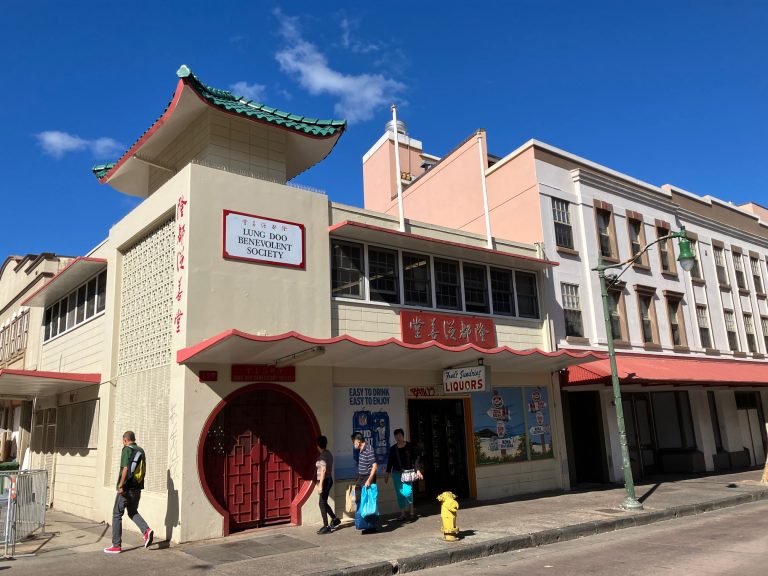The Chinese New Year celebrations led me to consider the contemporary significance of Chinatown for the Chinese community and its ethnic identity. While it continues as a visual representation of Chinese in Hawaii, as it has since the late 19th century, Chinatown as a long-time multiethnic area is hardly representative of the economically privileged status of Chinese in the islands.
Historically, Chinatown began to emerge in the 1880s when some Chinese, who wisely left the plantations once their labor contracts were over, settled in the area, which was then known as the “Native quarter” for its Hawaiian residents. Following the Chinatown fire in 1900, Chinese were no longer the largest ethnic group there because they had to leave after their homes and shops were destroyed, although some of them eventually returned.
Japanese then became the largest group in Chinatown after they moved in following the end of contract labor in 1900 and their eviction from the plantations for participating in the 1909 and 1920 strikes. They were joined by Filipinos, many of whom also had left the plantations in the 1920s and ’30s, contributing further to the multiethnic community that Chinatown has always been.
After World War II, other groups started businesses in Chinatown, such as African Americans who operated barber shops, night clubs and bars catering to young Black men either in or recently discharged from the military. Besides being residents, Filipinos also had businesses in Chinatown, notably the Mabuhay Café and Cebu Pool Hall, where retired plantation workers liked to hang out.
More recently, Filipinos have opened several small eateries in the Maunakea Marketplace. Vietnamese immigrants, some of whom are of Chinese ancestry, have added to the ethnic diversity of Chinatown by establishing a number of businesses along King St., including pho cafes, restaurants, jewelry shops and grocery stores.
For both a historical and contemporary perspective on Chinatown, fortunately for me, my longtime friend Franklin Ng resumed his annual visits to Honolulu for Chinese New Year after remaining in California during the Covid pandemic. I was thus able to interview him while having our usual dim sum lunch at one of his favorite restaurants.
Growing up in Chinatown on Vineyard Street and then in nearby Liliha in the 1950s and ’60s, Ng attended the private Island Paradise School that became the Mun Lun Cantonese language school in the afternoon, which he also attended. Both of his parents were Cantonese immigrants from southern China and worked in Chinatown.
His father, who had an elementary school education, was a butcher by trade and eventually got his own business by leasing a small stall at Oahu Market from 1957 until he retired in the early 1980s. Nonetheless, his parents provided Ng and his three siblings with private school and college educations, which demonstrates the socioeconomic mobility that used to be very possible in Hawaii for immigrant families.
In Ng’s case, after graduating from Iolani School, he attended Johns Hopkins University and subsequently earned an anthropology doctorate from the University of Chicago, where his brother went to medical school. Ng was a professor in Asian studies and anthropology at Fresno State University in California for 40 years until retiring in 2015.
I asked him about his memories of Chinatown during his youth. He related that it was “not uncommon” to see well-known Chinese business and political leaders, such as Chinn Ho, Hung Wo Ching and Hiram Fong, walking about Chinatown and stopping to chat with people.
Ng remembers it as a “face-to-face community where people walked to the markets to buy groceries, meat and fish. Different ethnic groups — Chinese, Japanese and Filipino — interacted with each other,” reflecting the multiethnic character of the community.
Besides grocery stores and restaurants, he noted that Chinatown businesses included imported goods shops, medical practitioners, herbal stores, pawn shops, theaters showing Chinese films and operas, crack seed stores and noodle factories. Chinese families, like those of some of his friends, used to live behind or above their businesses.

Also present in Chinatown were the meeting halls of district or surname associations mainly for immigrants from Guangdong province, the origin of most of the Chinese in Hawaii. Some of these organizations still own their buildings, which are narrow but extend further back from the street, creating considerable space.
I once joined a Chinatown tour led by Ng and was very surprised when he took us inside one of these multi-story meeting halls of the Lung Doo Benevolent Society on King Street. It seemed like a social center for elderly immigrants with free tea and cookies and Chinese cable television programs.
As for the contemporary role of Chinatown for the Chinese community, Ng asserts that it “is a means to maintain the Chinese cultural presence in Hawaii because people want to see cultural performances and celebrations, such as lion dances, martial arts demonstrations and the annual Chinese New Year’s parade.” Chinatown, and particularly its New Year celebrations, thus provide an example of symbolic ethnicity for Chinese, similar to how the concept applies to Japanese.
Contributing to this cultural maintenance among Chinese is immigration from China, which resumed in significant numbers starting in the 1990s, such that they are the second-largest group of annual immigrants to Hawaii after Filipinos. These immigrants provide the bulk of the service and sales workers in Chinese businesses in Chinatown, although most of them don’t live there.
With its numerous small businesses operated and staffed predominantly by Chinese immigrants, Chinatown provides a misrepresentation of Chinese identity and status in Hawaii. If one didn’t know of the majority third- and fourth-generation, highly-educated and professionally employed local Chinese, who certainly don’t reside in Chinatown or speak a Chinese language, one would be unaware of the high socioeconomic status of most Chinese in the islands.
While Chinatown persists as a cultural center of the Chinese community, its economic center is a short distance away on King Street in the downtown office towers where Hawaii’s largest corporations, banks, health care organizations, law firms, and insurance companies have their headquarters. Chinese occupy positions as the chief corporate officers, directors, and high ranking administrators in those corporations, which they share primarily with whites and Japanese.
The physical appearance of Chinatown together with continuous news reports and complaints of crime and homeless people in its environs obscure the power that Chinese have in Hawaii, which is primarily economic in nature rather than political, in contrast to Japanese.
As a scholar of race and ethnicity, I’ve found the absence of academic studies on Chinese in Hawaii for more than 30 years extremely disappointing. Fortunately, this year a historical work on Chinatown by Nancy Riley of Bowdoin College, “Chinatown, Honolulu: Place, Race, and Empire,” will be published by Columbia University Press.





